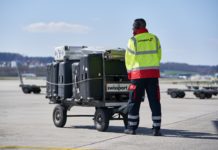

DGOffice B.V. is the specialised world leader of software solutions and services for dangerous goods and chemical management. The company is headquartered in the Netherlands.
Keeping it safe, secure, and simple
The key message about dangerous goods airfreight is the need to keep the cargo safe from the environment and the environment safe from the cargo. That remains the byword for all shipments, and everyone involved, whatever the product. Pursuing to be compliant with local and global legislation and regulations ease protection of our surroundings and ourselves. It’s easier said than done, but how does that work in practice?
Be your own captain of motivation and acceptance
Digital solutions have become a natural habit to carry out safety and compliance easily. There are many kinds of solutions, like platforms, SaaS, automated connectivity, and other initiatives, which keep evolving. These are not only driven by improving safety and compliance, but also to work smarter and smoothen the processes. Not to forget, another important motivator in the transport industry is to reduce the footprint that is left behind. For example, by using less paper, or ultimately go fully paperless.
Making digital data exchange possible is the answer to this, as well as to speeding up the process to get information sooner. Today, companies should use the Cargo XML instead of the older Cargo-IMP for airline messaging. However, for both messaging standards, the only part in the airfreight shipment documentation process that is not digitised yet is the Notification TO Captain (NOTOC). Currently, NTM messages are sent to ensure the NOTOC data can be loaded onto an aircraft computer. However, this is not a digital format. A NOTOC is basically a manifestation of data delivered from earlier parties.
Acceptance of a digital approach is key. All participants throughout the chain need to accept the digital format for it to succeed. This requires investments as well as system replacements or updates. As digital solutions provider DGOffice.net says it can establish functional systems for customers to help them move forward and push the transformation to go digital.
The solution to move forward
Ideally, the shipper initiates the process digitally, which is possible via DGOffice.net. However, not all are able or allowed to do this and therefore still use paper documents for the shipments. Fortunately, the IATA DG AutoCheck enables other parties, such as freight forwarders, ground handlers or airlines, to automatically verify the Dangerous Goods Declaration (DGD) and scan the paper version to a digital format. Nevertheless, there is still no data available for the NOTOC.
To make this possible anyhow, dnata adopted IATA DG AutoCheck for the acceptance check, whereas the dnata Brussels and Manchester locations use DGOffice.net simultaneously. By using the E-Freight Plus module in DGOffice.net, the generated (Cargo XML) data from IATA’s DG AutoCheck can be imported, validated, and made available in the NOTOC module. Within a few simple steps, the NOTOC is created, which can be exported to or shared with others, incl. as NTM message.










